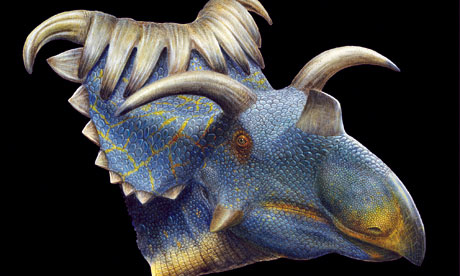Modern large herbivores are characterized by large geographical ranges often ranging across several ecosystems. Take a look below of the nearly continental range of the African Elephant before large scale human hunting and habitat loss (in grey).
Elephants follow the Jarman-Bell principle in that they are large bodied herbivores and can subsist on relatively low quality fodder- and their range reflects this. However the dinosaurian megaherbivores of Campanian age western North America seem to break all the rules (as dinos often do). Take a look at this map:
| A. Late Campanian 75mya B. Late Maastrichtian 65mya |
The western "island-continent" of North America in pic A is called Laramidia and is divided by the Pacific Ocean to the west and the Western Interior Seaway to the east. All vying for real estate on Laramidia during Campanian times were up to a dozen rhino sized and up dinosaurian megaherbivores. Dinosaur park in Alberta Canada, for example, documents six to eight large herbivores living synchronously together at various times through the Campanian. Contrast this scenario with what is seen by late Maastrichtian times in pic B where much of the seaway has drained away giving a much larger piece of land to live on. Here we see the iconic "Hell Creek" fauna famous for T-rex and usually containing at most two large herbivores, i.e. a species of Edmontosaur and a species of Triceratops (up in da' salad we do not believe in Torosaurus). Compounding the situation in Laramidia is the recent revelation that there appears to be distinctive north/south faunas of dinosaurs. Recent findings in southern Utah and New Mexico of critters such as Kosmoceratops suggest a division between northern and southern dinosaur faunas in the Campanian that roughly coincides with modern day Colorado and Utah.
 |
| Kosmoceratops richarsoni. Copyright Lukas Panzarin |
So not only were dino megaherbivores living together in great diversity on Larimidia- these large animals were also showing strong provincialism- individual species were not even spreading across the entire land mass... How ecologically could this be and, more importantly, how did this situation even arise?
What the authors argue is that orogonic activity (mountain building) effected the radiation of large dinosaur herbivore species. Involved are basically two mountain ranges. The first one is the Sevier Mountains which arose in the mid-Cretaceous and trended roughly north-south. Notice also that Laramidia trends north-south. Although a large range, the formation of the Sevier range did not significantly hamper dinosaur movements and there is no great north vs south disparity between dinosaur faunas at the time of its creation. However the Larimide orogonic event, a precursor to the Rocky Mountains, was a game changer. Unlike the Sevier range, these mountains arose longitudinally, east-west. The net effect was to "grid up" the whole of Laramidia, creating numerous small east-west basins hemmed in by ocean on either side. Coincident with the Larimide orogoney is the time of maximal dinosaur species diversity and also evidence of significant north-south provincialism. Long story short geographic barrier is in place and vicariance induced speciation takes over giving us the great species diversity of Campanian dino megaherbivores of Laramidia. When we get into the Maastichtian we see the Rockies start to rise further east, the inland sea drain away, and speciation rate/diversity levels drop off. The dinosaur species pump was turned off by the time of T'-rex.
The authors also speculate that changes in vegetation regimes with elevation/climate would have stifled dino megaherbivore movements between basins. Of course this flies in the face of the notion that all megaberhivores are generalists (something I want to address later)- but I don't dismiss it at face value. Dinos seem to break the rules a lot anyways. And even though there was a much more gradual temperature gradient north-south than in the present- we do see today even in the tropics dramatic changes in vegetation with elevation. Just look at the pic below of Mt. Kinabalu in Borneo, elevation 4, 095 meters (13,435 feet) where you can find alpine and even tundra biomes in tropical latitudes.
It should be noted that the authors concentrated their study on the two main groups of herbivorous dinos in the area- duckbills and horned dinos. This is not to suggest other groups were not following similar trends in radiation of species (dinos or other animals/plants)- its just that the data is best for these guys. Also their head ornamentation allows easy visual discrimination for us and themselves.
One final tid-bit, and this is my conjecture. Many herbivorous dinosaurs show strong nest site fidelity- nesting sites found show evidence they were used for many generations. Two separate populations of the same species with different nesting grounds probably had enough genetic flow between them to maintain species integrity. But now imagine that a mountain range appears that separates the two groups, even if not an impassible one, site fidelity to a nesting ground would further minimize genetic flow between the two populations. And voila- vicariance speciation follows.
Laramidia must have been a strange and wondrous place. A place of incredible diversity, not just of the small but the large as well. Anomalous, even for dinosaur standards, in the ridiculous variety of megafauna cohabiting in time and space. A place where by simply cresting an insignificant mountain pass one might find a whole separate flora/fauna waiting on the other side.
Pertinencia
Dinosaur Boom Linked to Rise of Rocky Mountains
http://www.livescience.com/22116-dinosaur-diversity-rocky-mountain-rise.html
(2012)
Mountain Building Triggered Late Cretaceous North American Megaherbivore Dinosaur Radiation.
PLoS ONE 7(8):
e42135.
doi:10.1371/journal.pone.0042135
 |
| Copyright Sammy @ http://dino-art.blogspot.com/ |
Support me on Patreon.
Like antediluvian salad on facebook.
Watch me on Deviantart @NashD1.Subscribe to my youtube channel Duane Nash.
My other blog southlandbeaver.blogspot.



No comments:
Post a Comment